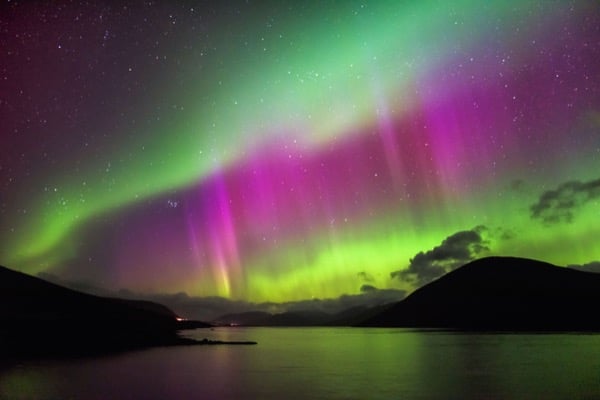Ask anyone who has seen the northern lights, and they will tell you that it is an experience unlike any other. But the question “Do they really look like that?” may have crossed your mind after seeing pictures or videos of the northern lights. Well, the answer to that is simple; Sometimes. And since they occur naturally, they cannot be stopped. However, there are ways to improve your chances of witnessing a spectacular display of the northern lights if you are planning a trip to see them. Here in this article is some advice on how to best experience the northern lights and the working principle behind them.
What Exactly Are the Northern Lights?
The northern lights, also known as the aurora borealis, are an atmospheric phenomenon in which undulating waves of green, purple, and red lights dance across the sky. They occur when the sun’s energized particles, known as the solar wind, bombard our atmosphere.
However, we are shielded from the impact on the surface by the Earth’s magnetic field.
The particles travel along the magnetic field to the planet’s poles, where an energy exchange results in the colorful lights in the sky. The northern lights occur in the northern hemisphere, while the aurora australis, or southern lights, occur in the southern hemisphere.
Where Are the Northern Lights Visible?
The auroral zone — the region of the northern hemisphere within a 1,500-mile radius of the magnetic north pole — is the best place to see the northern lights. This includes northern Norway, Sweden, Finland, Canada, Alaska, and Russia, as well as Svalbard, Iceland, and Greenland, as well as most destinations north of latitude 66°33’N.
The northern lights can move much further south during particularly strong periods of solar wind known as geomagnetic storms, even appearing in the United States. However, because it is impossible to predict when these storms will occur, your best bet for seeing the northern lights is to visit locations within the auroral zone, where the phenomenon occurs most frequently.
What Exactly Is the Aurora?
The northern and southern hemispheres’ poles can both be seen with the aurora. The display is known as the aurora borealis in the north and the aurora australis in the south.
For centuries, these ‘northern and southern lights’ have fascinated, terrified, and inspired humans. Photographers have recently gone to extraordinary lengths to capture the beauty of these atmospheric events.
What Causes the Aurora Borealis, Also Known as the ‘Northern Lights’?
The lights we see in the night sky are actually caused by activity on the Sun’s surface.
Solar storms on the surface of our star produce massive clouds of electrically charged particles. These particles can travel millions of miles before colliding with the Earth.
Most of these particles are deflected away, but some become trapped in the Earth’s magnetic field, accelerating down into the atmosphere near the north and south poles. Because of this, aurora activity is concentrated near the magnetic poles.
“These particles then slam into atoms and molecules in the Earth’s atmosphere, essentially heating them up,” Royal Observatory astronomer Tom Kerss explains. “We call this physical process ‘excitation,’ but it’s similar to heating a gas and causing it to glow.”
As a result, we are witnessing atoms and molecules in our atmosphere colliding with particles from the Sun. The lines of force in the Earth’s magnetic field cause the aurora’s characteristic wavy patterns and ‘curtains’ of light.
An aurora’s lowest point is usually around 80 miles above the Earth’s surface. The top of a display, on the other hand, may extend several thousand miles above the Earth.
What Causes Aurora’s Various Colors?
When different gases are heated, they emit different colors. The same thing is happening in the aurora.
Nitrogen and oxygen are the two primary gases in the Earth’s atmosphere, and these elements emit different colors during an aurora display.
The green in the aurora is caused by oxygen, whereas hints of purple, blue, or pink are caused by nitrogen.
Is the Northern Lights Visible in the United Kingdom?
The northern hemisphere is home to the aurora borealis, while the southern hemisphere is home to the aurora australis.
Grigorii Paramonov, Astronomy Photographer of the Year 2019, captured the polar lights.
While the best places to see the aurora are in the polar regions, the aurora borealis can occasionally be seen in the United Kingdom. The northern lights are more likely to be seen further north, but they have been seen as far south as Cornwall and Kent in the past.
The Department of Physics at Lancaster University operates the AuroraWatch UK website, which predicts the likelihood of an aurora based on geomagnetic activity. Follow the team’s Twitter account to stay up to date on the latest UK alerts.
However, the conditions must still be met. The best chance of seeing the aurora is on dark and clear nights, preferably with little light pollution.
Are There Aurorae on Other Planets?
Aurorae are likely on any planet with an atmosphere and a magnetic field. Amazing images of aurorae on Jupiter, Saturn, Uranus, and Neptune have been captured by scientists.
Aurorae have also been observed on Mars, but because the ‘red planet’ lacks a global magnetic field, aurorae behave differently and appear to be far more widespread.
What exactly are solar flares, and how do they influence the aurora?
The aurora borealis is a spectacular example of how solar activity affects the Earth.
Solar flares are massive explosions on the Sun’s surface that emit streams of charged particles into space. The particles usually reach Earth two days after the flare is seen on the Sun. These particles can cause aurora activity when they arrive.
What Causes the Northern Lights’ Various Colors?
At various levels in the atmosphere, different atoms make up the Earth’s atmosphere. These atoms are excited when particles from the sun collide with them, resulting in the colors seen in the Northern Lights.
Green is the most common color seen in the Northern Lights. When millions of oxygen atoms in the Earth’s atmosphere collide at the same time, they emit the green hue we see from the ground.
Oxygen atoms are also responsible for the red light seen in the aurora. These particles are found higher up in the atmosphere and emit a lower-energy red light. Although red is always present, our eyes are five times less sensitive to red light than green, so we don’t always notice it.
Nitrogen makes up a large portion of the Earth’s atmosphere, but particles from the solar wind must strike these atoms much harder for them to become excited. When this occurs and the nitrogen atoms begin to decay, they emit a purple light. This is a very rare color to see, and it usually occurs only during a particularly active auroral display.
What Are Geomagnetic Storms?
Massive explosions on the Sun, known as ‘coronal mass ejections, ‘ cause intense aurora displays. These explosions produce clouds of hot plasma containing billions of tons of material that travel at approximately two million miles per hour. When the clouds reach the Earth, they interact with the magnetic field, causing geomagnetic storms.
The Sun’s activity varies, with a peak occurring every 11 years. Solar activity last peaked in 2014, and the cycle is now at its lowest point. However, solar activity is expected to increase again until the mid-2020s.
Aurorae can occur at any time, regardless of the Sun’s activity, and observers in high latitudes should always keep an eye out for them.
When Are the Best Months to See the Northern Lights?
The northern lights appear nearly every day of the year, but they are not always visible. To see them, you must have the proper viewing conditions. The most critical factor is darkness. Given that you’ll need to travel quite far north to see the northern lights, you’ll almost certainly run into daylight issues — in the summer, high-latitude destinations experience a phenomenon known as the midnight sun, which means they have extremely long days, some with up to 24 hours of sunlight.
So you’ll have to wait until the fall, winter, or spring to experience darkness and thus have a chance to see the northern lights. Solar activity typically peaks around the autumn and spring equinoxes, which occur in September and March, respectively, but the northern lights can be seen throughout the winter at any time between those dates.
What Time of Day Is Best to See the Northern Lights?
The simple answer is: whenever it is dark outside! The northern lights typically appear in short bursts of 15 to 30 minutes, and they can occur at any time — even in the middle of the day, though you wouldn’t be able to see them if it was light out. However, statistically, your best chances are between 10 p.m. and 2 a.m. local time. If you’re going to a place known for seeing the northern lights, your hotel may provide wake-up calls if the lights appear in the middle of the night while you’re sleeping.
Otherwise, plan on staying up all night watching the skies. There is one exception to this general rule: if you visit a very northern destination in the dead of winter, you may experience a polar night, which lasts 24 hours. (This occurs in locations such as Svalbard.) In that case, the northern lights can be seen at any time of day.
What Other Ways Can I Improve My Chances of Seeing the Northern Lights?
Beyond the darkness, there are additional viewing conditions required for viewing the northern lights: clear skies, preferably without a bright moon (which can drown out the northern lights). While you can plan your trip to a northern lights destination around a new or crescent moon, you have no control over the weather.
Furthermore, the northern lights are highly unpredictable beyond a few days, and even then, forecasts aren’t always accurate. (You can verify those forecasts by visiting the National Oceanographic and Atmospheric Administration’s Space Weather Prediction Center.)
The northern lights can be weak at times, producing only a dim glow, or they can completely illuminate the night sky. While seeing the northern lights is never guaranteed, the best way to increase your chances is to plan a longer trip. The more days you spend up north, the more likely it is that you will not only have clear skies but also a powerful geomagnetic storm that will produce the most brilliant northern lights.
Related Articles
- TESLA SOLAR: Panels, Powerwall, & Solar Roof 2023 (Updated)
- Vegan Brands Bread: 19+ Gluten-Free Vegan Bread Brands.
- The Playbook of Long-Term Stock Investing
- Student Loans Company Guide: All You Should Know (+ free tips)
- Student Finance: Grants, Loans, Applications (+ How to Start Guide)






